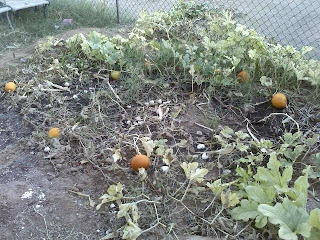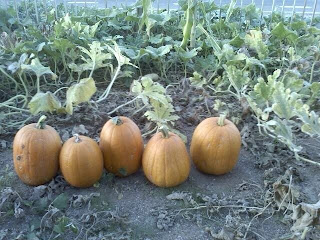





Extreme heat gardening -- meaning two+ months of 110+ degree heat -- YEAH, WE DO THAT!
The cucumbers have been my biggest "pleasant surprise". They outlasted the corn and sunflowers, and in fact, they are fruiting more in August than they did in July. Many of the leaves are getting tough and yellowing, but the flowers just keep producing and producing! I already have about 20 jars of pickles, so mainly the chickens have been enjoying the bounty...
I also planted late-June pumpkins seeds, hoping for nice big gourds for Halloween, and "so far, so good". One of my earliest and most promising vines died (due to one day of negligence), but the vines are growing like crazy now, and some fruits have started to set. I am growing three varieties this year: Big Max, Jack-o-Lantern, and Sugar Baby.
And, oh yeah, my watermelons are still producing, too! Unfortunately, the very day before a big BBQ birthday party last week, the chickens escaped their coop and pecked holes in 6 big jubilee watermelons! Oh well, more coming...
Keys to "Beating the Heat"
-Flood irrigate in the morning.
In other times of the year, I prefer to irrigate at night, to avoid day-time evaporation, giving the roots plenty of time to soak all night. But I have found that when it hits 110+ degrees, the ground is too dry by late afternoon and the vines struggle. When I flood irrigate in the morning before I go to work, even in the 110+ heat, the vines are doing fine when I get home from work. If it was a superhot day (115+) and the leaves are struggling, I will flood irrigate in the evening too.
-Don't spray water during the day
It has been shown that water droplets focus lightwaves, and this can actually damage your leaves if you spray water during the day. If you need to cool off your plants during daylight hours, do it with flood irrigation, avoid spraying the leaves.
-Partial shade helps
The more partial shade the better, especially in the late afternoon. It is not a necessity, as my full-sun pumpkin vines are doing fine this summer, but it does help give you more "margin for error". The most important thing is keeping the ground wet. If you don't have a wall or tree to provide the shade, interplant some sunflowers, or even corn, to help provide some shade.
Dealing with Bermuda Grass
If you had bermuda grass anywhere near your garden at the beginning of summer, after a couple months of flood irrigation, it will completely take over your garden space. It is almost impossible to avoid, unless you are so dedicated that you can devote hours a week to pulling weeds in the extreme heat.
The good news is, the bermuda grass will provide SHADE and COOLING to your mature plants. I have kept tomatoes and beets growing all summer by letting the grass go crazy around them. Come fall, just till it under as biomass to enrich your soil for winter. As bermuda grass is naturally dormant during the winter, you will be able to garden right over it, and put off the serious thinning to next summer.

































